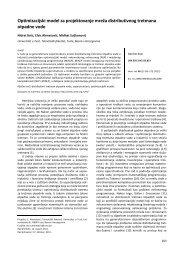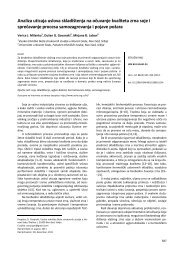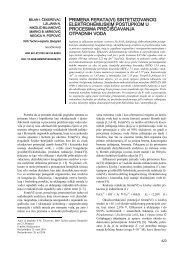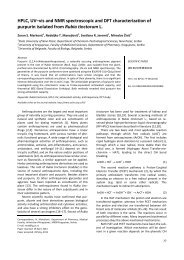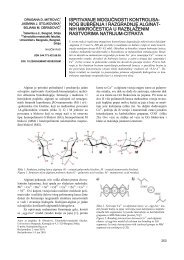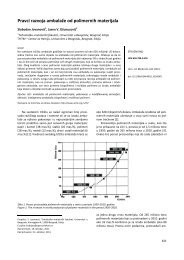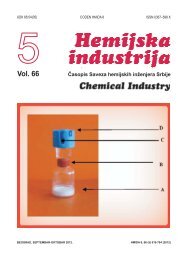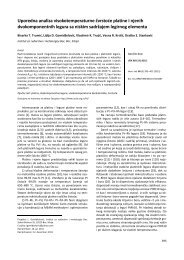Imobilizacija enzima na ugljenične nanocevi - doiSerbia
Imobilizacija enzima na ugljenične nanocevi - doiSerbia
Imobilizacija enzima na ugljenične nanocevi - doiSerbia
You also want an ePaper? Increase the reach of your titles
YUMPU automatically turns print PDFs into web optimized ePapers that Google loves.
N.Ž. PRLAINOVIĆ i sar.: IMOBILIZACIJA ENZIMA NA UGLJENIČNE NANOCEVI Hem. ind. 65 (4) 423–430 (2011)<br />
SUMMARY<br />
IMMOBILIZATION OF ENZYMES ONTO CARBON NANOTUBES<br />
Neve<strong>na</strong> Ž. Prlainović, Dejan I. Bezbradica, Zorica D. Knežević-Jugović, Aleksandar D. Marinković, Dušan Ž. Mijin<br />
Faculty of Technology and Metallurgy, University of Belgrade, Belgrade, Serbia<br />
(Review paper)<br />
The discovery of carbon <strong>na</strong>notubes (CNTs) has opened a new door in <strong>na</strong>notechnology.<br />
With their high surface area, unique electronic, thermal and mechanical<br />
properties, CNTs have been widely used as carriers for protein immobilization.<br />
In fact, carbon <strong>na</strong>notubes present an ideal support system without diffusio<strong>na</strong>l<br />
limitations, and also have the possibility of surface covalent functio<strong>na</strong>lization.<br />
It is usually the oxidation process that introduces carboxylic acid groups.<br />
Enzymes and other proteins could be adsorbed or covalently attached onto<br />
carbon <strong>na</strong>notubes. Adsorption of enzyme is a very simple and inexpensive immobilization<br />
method and there are no chemical changes of the protein. It has also<br />
been found that this technique does not alter structure and unique properties of<br />
<strong>na</strong>notubes. However, a major problem in process designing is the relatively low<br />
stability of immobilized protein and desorption from the carrier. On the other<br />
hand, while covalent immobilization provides durable attachment, the oxidation<br />
process can reduce mechanical and electronic properties of carbon <strong>na</strong>notubes. It<br />
can also affect the active site of enzyme and cause the loss of enzyme activity.<br />
Bioimmobilization studies have showed that there are strong interactions between<br />
carbon <strong>na</strong>notubes surface and protein. The retention of enzyme structure<br />
and activity is critical for their application and it is of fundamental interest to<br />
understand the <strong>na</strong>ture of these interactions. Atomic force microscopy (AFM),<br />
transmission electron microscopy (TEM), scanning electron microscopy (SEM) and<br />
circular dichroism (CD) spectroscopy provide an insight into the structural changes<br />
that occur during the immobilization. The aim of this paper is to summarize progress<br />
of protein immobilization onto carbon <strong>na</strong>notubes.<br />
430<br />
Keywords: Carbon <strong>na</strong>notubes • Enzyme<br />
immobilization • Adsorption • Covalent<br />
attachment




